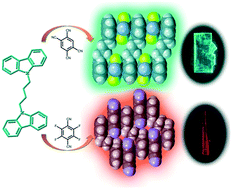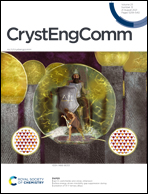Acceptor-regulated luminescence in carbazole-based charge transfer complexes†
Abstract
A dicarbazole derivative (CC4C) was synthesized and used as an electron donor to construct charge-transfer co-crystals with 1,4-dicyanotetrafluorobenzene (DCTFB) and 1,2,4,5-tetracyanobenzene (TCNB) to investigate the effect of electron acceptors on the molecular stacking and photoluminescence behaviors of crystals. The results suggested that face-to-face and T-shaped dimers were present in the rodlike crystals of CC4C, and DCTFB and TCNB formed co-crystals with CC4C. The two co-crystals possessed the same crystal system and space group, and molecules formed 1D columns, in which donors and acceptors stacked in a mixed –D–A–D–A– fashion with a strong π–π overlap because of their short distances. However, the weak interactions between the columns in the two co-crystals were different. Additional H⋯F hydrogen bonds existed in the co-crystals of CC4C and DCTFB besides C![[double bond, length as m-dash]](https://www.rsc.org/images/entities/char_e001.gif) N⋯H hydrogen interactions in the co-crystals of CC4C and TCNB because of the four fluorine atoms in DCTFB. More importantly, the acceptors might regulate the fluorescence properties of the co-crystals. The block co-crystals with DCTFB are yellowish and emitted strong blue-green fluorescence, and the red co-crystals with TCNB have orange-red emission under UV light. Quantum chemical calculations implied that the energy level of the lowest unoccupied molecular orbitals of the acceptors determined the transition energies and a lower lowest unoccupied molecular orbital will induce a longer emission wavelength.
N⋯H hydrogen interactions in the co-crystals of CC4C and TCNB because of the four fluorine atoms in DCTFB. More importantly, the acceptors might regulate the fluorescence properties of the co-crystals. The block co-crystals with DCTFB are yellowish and emitted strong blue-green fluorescence, and the red co-crystals with TCNB have orange-red emission under UV light. Quantum chemical calculations implied that the energy level of the lowest unoccupied molecular orbitals of the acceptors determined the transition energies and a lower lowest unoccupied molecular orbital will induce a longer emission wavelength.

- This article is part of the themed collection: Crystal Growth


 Please wait while we load your content...
Please wait while we load your content...